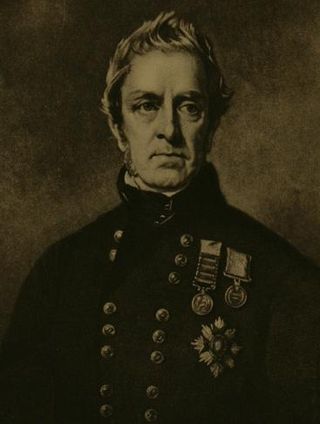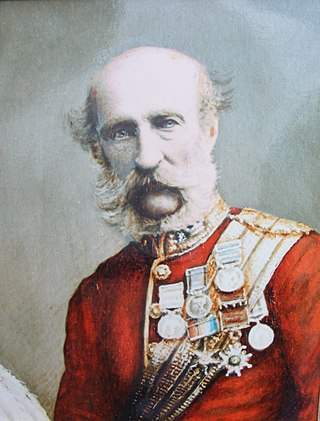Related Research Articles

Epaulette is a type of ornamental shoulder piece or decoration used as insignia of rank by armed forces and other organizations. Flexible metal epaulettes are referred to as shoulder scales.

General Henry Duncan Graham Crerar was a senior officer of the Canadian Army who became the country's senior field commander in the Second World War as commander of the First Canadian Army in the campaign in North West Europe in 1944–1945, having rapidly risen in rank from brigadier in 1939 to that of a full general in 1944.

Field Marshal Sir George Pollock, 1st Baronet was a British Indian Army officer. He first saw action at the Battle of Deeg and at the Siege of Bhurtpore during the Second Anglo-Maratha War before taking part in the Anglo-Nepalese War. He also commanded the British artillery at the Battle of Prome and at Bagan during the First Anglo-Burmese War. Following a disastrous retreat from Kabul in January 1842 during the First Anglo-Afghan War, the retreating forces became stranded at the small British garrison at Jalalabad and Pollock was appointed Commander of the Force sent to relieve the garrison: he advanced through the Khyber Pass and relieved the garrison in April 1842. He then set about an unauthorised but ultimately successful mission to rescue the British hostages who had been left behind in Kabul prior to the retreat. In 1844 the Pollock Medal was created to commemorate Pollock's achievements: this medal was to be awarded to the "best cadet of the season" at the Addiscombe Military Seminary.

Major General Sir Alexander Dickson was a British Army officer who served in the artillery. He fought at many battles during the Napoleonic Wars. Arthur Wellesley, 1st Duke of Wellington had the highest opinion of his abilities and made him the effective commander of his army's artillery during the latter part of the Peninsular War.
Edward Montagu (1755–1799), Indian officer, was youngest son of Admiral John Montagu, and brother to Admiral Sir George Montagu and Captain James Montagu.
E Battery Royal Horse Artillery is a Close Support Battery of 1st Regiment Royal Horse Artillery. It is currently based in Purvis Lines in Larkhill Camp.

D Battery Royal Horse Artillery are a Precision Strike/Deep Fires Battery of 3rd Regiment Royal Horse Artillery They are currently based in Albemarle Barracks in Newcastle Upon Tyne.
General Sir Anthony Farrington, 1st Baronet DCL was a British Army officer of the Royal Artillery. He served in Gibraltar and in the American War of Independence.
George Fead (1729?–1815), was a lieutenant-general and colonel-commandant fourth battalion Royal Artillery.
Lieutenant is a junior officer rank in the British Army and Royal Marines. It ranks above second lieutenant and below captain and has a NATO ranking code of OF-1 and it is the senior subaltern rank. Unlike some armed forces which use first lieutenant, the British rank is simply lieutenant, with no ordinal attached. The rank is equivalent to that of a flying officer in the Royal Air Force (RAF). Although formerly considered senior to a Royal Navy (RN) sub-lieutenant, the British Army and Royal Navy ranks of lieutenant and sub-lieutenant are now considered to be of equivalent status. The Army rank of lieutenant has always been junior to the Navy's rank of lieutenant.
Albert Borgard was a Danish artillery and engineer officer.
Brigadier-General Walter Buckingham Caddell was a Royal Artillery, Royal Flying Corps and Royal Air Force officer who served in a number of senior military aviation appointments during World War I.

General George Campbell of Inverneill, CB, KA (1803–1882) was Commandant of the Royal Artillery and served in the East India Company.
Captain John Northall (1723?–1759) was an officer of the British Army and a writer.
Major Richard Maitland was a British Army officer who served in the Royal Artillery, and the captor of Surat while in the service of the East India Company.

Lieutenant-General Robert Lawson was a British Army officer who served in the Royal Artillery during the American War of Independence and the Egyptian Campaign.
Lieutenant-General Forbes Macbean was a British Army officer of the Royal Artillery.
The 1896 Birthday Honours were appointments by Queen Victoria to various orders and honours to reward and highlight good works by citizens of the British Empire. The appointments were made to celebrate the official birthday of The Queen, and were published in The London Gazette on 20 May and 26 May and in The Times on 20 May 1896.
The 1873 Birthday Honours were appointments by Queen Victoria to various orders and honours to reward and highlight good works by citizens of the British Empire. The appointments were made to celebrate the official birthday of the Queen, and were published in The London Gazette on 24 May 1873.
References
- Francis Duncan, History of the Royal Regiment of Artillery, volume I. London, 1879 (third edition)